A Defense of the Johannine Comma - Study to Answer.Net
A Defense of the Johannine Comma - Study to Answer.Net
A Defense of the Johannine Comma - Study to Answer.Net
You also want an ePaper? Increase the reach of your titles
YUMPU automatically turns print PDFs into web optimized ePapers that Google loves.
"The Holy Spirit Himself also, which operates in <strong>the</strong> prophets, we assert <strong>to</strong> be an<br />
effluence <strong>of</strong> God, flowing from Him, and returning back again like a beam <strong>of</strong> <strong>the</strong><br />
sun. Who, <strong>the</strong>n, would not be as<strong>to</strong>nished <strong>to</strong> hear men who speak <strong>of</strong> God <strong>the</strong><br />
Fa<strong>the</strong>r, and <strong>of</strong> God <strong>the</strong> Son, and <strong>of</strong> <strong>the</strong> Holy Spirit, and who declare both <strong>the</strong>ir<br />
power in union and <strong>the</strong>ir distinction in order, called a<strong>the</strong>ists?" 61<br />
Hence, A<strong>the</strong>nagorus connects <strong>the</strong> Fa<strong>the</strong>r, <strong>the</strong> Son (whom he had previously<br />
referred <strong>to</strong> as "<strong>the</strong> Logos", <strong>the</strong> Word), and <strong>the</strong> Holy Spirit, stating both <strong>the</strong>ir union and<br />
<strong>the</strong>ir distinction in order. The only portion <strong>of</strong> Scripture where <strong>the</strong>se two points are<br />
juxtaposed in such a manner is I John 5:7. That A<strong>the</strong>nagorus likely had this verse in mind<br />
is suggested by his prior usage <strong>of</strong> <strong>the</strong> term "Logos", which is not used in John 10:30, and<br />
hence would not be <strong>the</strong> source <strong>of</strong> this term in connection with <strong>the</strong> unity <strong>of</strong> <strong>the</strong> Son and <strong>the</strong><br />
Fa<strong>the</strong>r. Fur<strong>the</strong>r, we should note that <strong>the</strong> development <strong>of</strong> more intricate definitions <strong>of</strong> <strong>the</strong><br />
Trinity that would rely upon <strong>the</strong> distinction <strong>of</strong> <strong>the</strong> Persons in <strong>the</strong>ir order <strong>of</strong> procession<br />
should not be anachronized back on<strong>to</strong> A<strong>the</strong>nagorus, for <strong>the</strong>se precise <strong>the</strong>ological<br />
definitions and discussions arose much later. When A<strong>the</strong>nagorus describes <strong>the</strong> "power in<br />
union and <strong>the</strong>ir distinction in order," <strong>the</strong> most logical conclusion is that he has I John 5:7,<br />
ra<strong>the</strong>r than Augustine or Hilary (obviously!), in mind.<br />
Though A<strong>the</strong>nagorus' usage is not definite, we next find a much more definite use<br />
<strong>of</strong> this verse by Tertullian around 200 AD. In his apologetic work Against Praxeas, He<br />
makes <strong>the</strong> statement concerning <strong>the</strong> Trinity,<br />
"Thus <strong>the</strong> connection <strong>of</strong> <strong>the</strong> Fa<strong>the</strong>r in <strong>the</strong> Son, and <strong>of</strong> <strong>the</strong> Son in <strong>the</strong> Paraclete,<br />
produces three coherent Persons, who are yet distinct One from Ano<strong>the</strong>r. These<br />
Three are one essence, not one Person, as it is said, 'I and my Fa<strong>the</strong>r are One,' in<br />
respect <strong>of</strong> unity <strong>of</strong> substance not singularity <strong>of</strong> number." 62<br />
While Tertullian here quotes John 10:30 so as <strong>to</strong> elucidate <strong>the</strong> point he makes<br />
about <strong>the</strong> unity <strong>of</strong> essence, and not <strong>of</strong> number, among <strong>the</strong> Persons <strong>of</strong> <strong>the</strong> Godhead, his<br />
language concerning all three Persons is strikingly particular <strong>to</strong> that found in I John 5:7.<br />
He quotes "<strong>the</strong>se three are", and <strong>the</strong>n clarifies that <strong>the</strong> "one" is a one <strong>of</strong> substance and<br />
essence, not person. Quite clearly, this is a reference <strong>to</strong> <strong>the</strong> <strong>Comma</strong>. What is important <strong>to</strong><br />
keep in mind, also, is that Against Praxeas is a work specifically designed <strong>to</strong> explain and<br />
defend <strong>the</strong> doctrine <strong>of</strong> <strong>the</strong> Trinity against Sabellianism, which is why Tertullian takes<br />
pains <strong>to</strong> note <strong>the</strong> unity is one <strong>of</strong> essence and not <strong>of</strong> person. Thus, it's use nearly a century<br />
and a half before <strong>the</strong> Trinitarian controversies (during which <strong>the</strong> supposed silence <strong>of</strong> <strong>the</strong><br />
patristics on <strong>the</strong> verse is said <strong>to</strong> suggest that <strong>the</strong>y did not know <strong>of</strong> <strong>the</strong> verse) <strong>to</strong> defend <strong>the</strong><br />
doctrine <strong>of</strong> <strong>the</strong> Trinity is remarkable in itself, as it shows that <strong>the</strong> verse DID find witness<br />
and was employed on this very subject.<br />
61 Ibid.<br />
62 Tertullian, Against Praxeas, Ch. 25<br />
28


